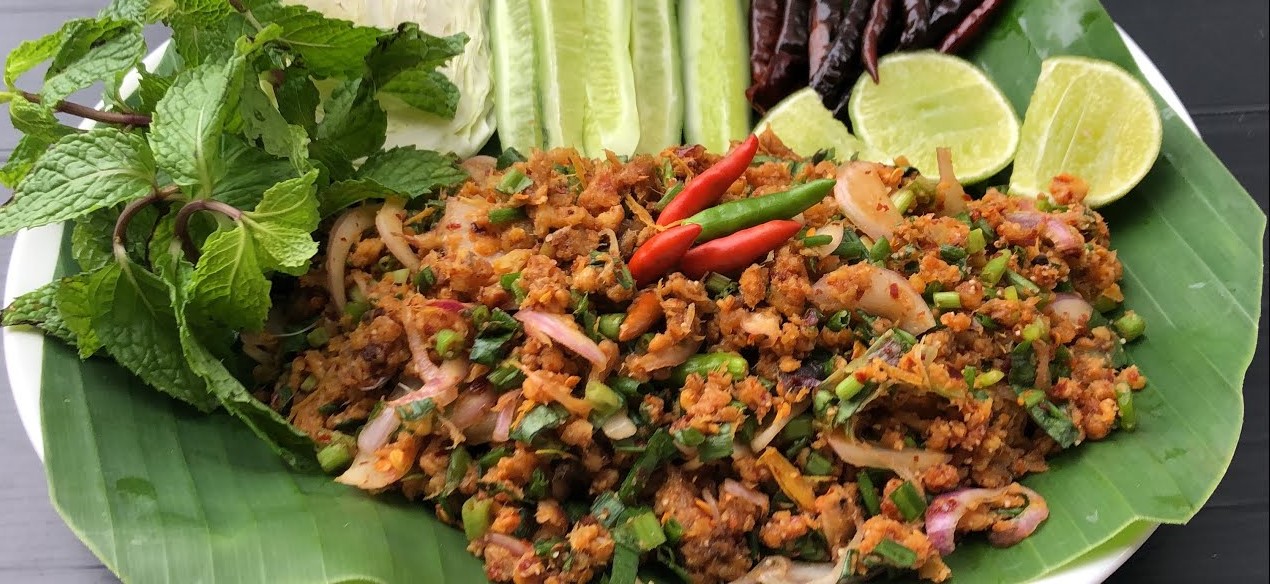By Josh Butterworth , Teacher in Phetchabun, Thailand
Friday night after a long week, nine to five times five. You stop at the shop on your way home and ponder over ingredients you could use to make dinner. You leave the shop with nothing but a four pack of cheap lager and start scrolling through takeaway menus. You flirt with a Chinese, are tempted by pizza, maybe Indian, but settle on Thai. Jumping up like a kid on Christmas morning when the doorbell rings, you thank the delivery driver and hand over at least a couple of hours wages. Ouch, but hey, it’s Friday. Inside that steamy bag of joy there are some prawn crackers, a pad Thai, a green curry, and don’t forget the fried rice too. Overordered? Give me a break, it’s Friday. Feeling like you’re sitting on a plastic stool in a smokey side street of Bangkok or Chiang Mai, you say to yourself “this is bloody lovely, so authentic, I must go to Thailand one day to eat all of this amazing food straight from the wok”. Years later, after nine to five times a really big number, you’ve saved up and are headed for the Land of Smiles. But all the takeaways in the world, from Bangkok Palace or The Happy Buddha, simply cannot prepare you for real, authentic, incredible, spicy, salty, sweet, sour, crunchy, soft, spicy, fishy, meaty, delicious, spicy, wonderful, gorgeous and fantastic cuisine that I am incredibly blessed to eat in Thailand every day. In this article I will share with you ten dishes that I had never heard of until landing in this wonderful country with a rumbling belly. I looked at what the locals were eating and ordered the same. I hope this article can act as some sort of guide for those who want to have a Thai taste adventure but don’t know where to start.
Pad Krapow
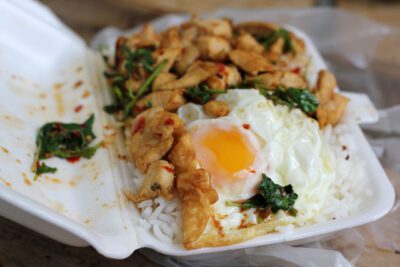 Pad Thai is famous across the world, but Pad Krapow is Thailand’s best kept secret. A dish that’s as popular within its own borders as sandwiches or burgers are in the west, it’s the fast food of Thailand and I’m shocked it hasn’t yet conquered the world. Pad meaning fried and Krapow being the Thai word for holy basil, the name of the dish is essentially fried holy basil. Holy? The herb that originates from the Indian subcontinent and grows like a weed across southeast Asia is sacred in the Hindu religion and has a range of health benefits. Krapow, or holy basil, is somewhat similar to the Italian basil that we all know so well, but has a warm and sweet flavor with undertones of licorice, cloves, lemon and peppermint. It’s very difficult to describe so you’ll just have to try it yourself. Traditionally, the dish contains minced chicken or pork, but can be made with fish or seafood for pescatarians, or tofu or mushrooms for vegetarians, although you may struggle to find veggie options away from tourist areas. The beauty of this dish is its simplicity. The protein is fried then onions and long beans are added to give the dish crunch and a crisp freshness, the perfect combination of oyster, soy and fish sauce deliver powerful depth of flavor, and of course chili and garlic give that kick that leaves you coming back for more. Then the basil is added, the flame is killed, and the magic happens. Herbal, spicy, aromatic, and full of flavor. This dish is a winner. Served with rice and a perfectly crisp fried egg, Thai style, it really can’t be beaten. I’m sure you’re going to love it.
Pad Thai is famous across the world, but Pad Krapow is Thailand’s best kept secret. A dish that’s as popular within its own borders as sandwiches or burgers are in the west, it’s the fast food of Thailand and I’m shocked it hasn’t yet conquered the world. Pad meaning fried and Krapow being the Thai word for holy basil, the name of the dish is essentially fried holy basil. Holy? The herb that originates from the Indian subcontinent and grows like a weed across southeast Asia is sacred in the Hindu religion and has a range of health benefits. Krapow, or holy basil, is somewhat similar to the Italian basil that we all know so well, but has a warm and sweet flavor with undertones of licorice, cloves, lemon and peppermint. It’s very difficult to describe so you’ll just have to try it yourself. Traditionally, the dish contains minced chicken or pork, but can be made with fish or seafood for pescatarians, or tofu or mushrooms for vegetarians, although you may struggle to find veggie options away from tourist areas. The beauty of this dish is its simplicity. The protein is fried then onions and long beans are added to give the dish crunch and a crisp freshness, the perfect combination of oyster, soy and fish sauce deliver powerful depth of flavor, and of course chili and garlic give that kick that leaves you coming back for more. Then the basil is added, the flame is killed, and the magic happens. Herbal, spicy, aromatic, and full of flavor. This dish is a winner. Served with rice and a perfectly crisp fried egg, Thai style, it really can’t be beaten. I’m sure you’re going to love it.
Som Tam
Standing on the side of the road in Krabi, 2020, waiting for a bus to Bangkok, I fell in love with this dish the very first time I took a bite. In my whole life, I hadn’t tasted anything like it, and to this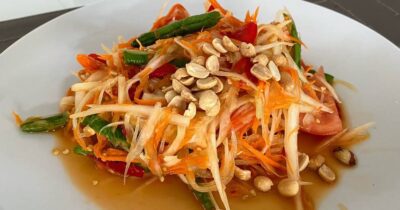 day I eat it several times a week. Partly due to the fact it’s healthy, somewhat, but mainly because there’s such a massive variety of options, and it goes well with everything. It seems that Thai people agree with me, as the dish in its many forms is eaten all the time and everywhere, from building sites to staffrooms to executive offices in Bangkok skyscrapers, the pungent smell of Som Tam is never too far away. I’m a fan of strong flavors, an attribute that will do you well in Thailand, so this salad hits all the right places. The standard Som Tam consists of green papaya, tomatoes and long beans, that are pounded using a huge pestle and mortar. It’s quite a sight to see, old ladies usually, pounding away, strong as anything. The zingy flavor is brought by lime juice, fish sauce, dried shrimps, toasted peanuts and of course chilis. But that’s just the classic, traditional Som Tam. Using almost every fruit and vegetable available in Thailand, and different sea-based flavors such as fermented crab, fish and oysters, as well as a variety of proteins and sometimes noodles, the Som Tam possibilities are endless. You simply must try it. And whether you are a spice head or not, I recommend starting small and working your way up, they don’t mess about here. Start with traditional Som Tom, or green papaya salad, as the flavors aren’t too offensive, and go from there. Som Tam is usually enjoyed with sticky rice and grilled chicken, and you can usually find all three components being sold together at the same stall on roadsides everywhere you go, each with different variations and styles. But what you can guarantee, is they’ll all be delicious.
day I eat it several times a week. Partly due to the fact it’s healthy, somewhat, but mainly because there’s such a massive variety of options, and it goes well with everything. It seems that Thai people agree with me, as the dish in its many forms is eaten all the time and everywhere, from building sites to staffrooms to executive offices in Bangkok skyscrapers, the pungent smell of Som Tam is never too far away. I’m a fan of strong flavors, an attribute that will do you well in Thailand, so this salad hits all the right places. The standard Som Tam consists of green papaya, tomatoes and long beans, that are pounded using a huge pestle and mortar. It’s quite a sight to see, old ladies usually, pounding away, strong as anything. The zingy flavor is brought by lime juice, fish sauce, dried shrimps, toasted peanuts and of course chilis. But that’s just the classic, traditional Som Tam. Using almost every fruit and vegetable available in Thailand, and different sea-based flavors such as fermented crab, fish and oysters, as well as a variety of proteins and sometimes noodles, the Som Tam possibilities are endless. You simply must try it. And whether you are a spice head or not, I recommend starting small and working your way up, they don’t mess about here. Start with traditional Som Tom, or green papaya salad, as the flavors aren’t too offensive, and go from there. Som Tam is usually enjoyed with sticky rice and grilled chicken, and you can usually find all three components being sold together at the same stall on roadsides everywhere you go, each with different variations and styles. But what you can guarantee, is they’ll all be delicious.
Sukiyaki
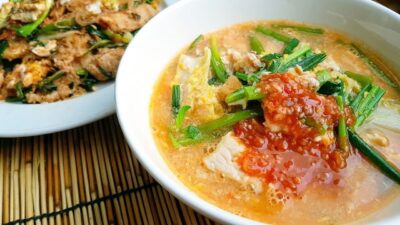 There are three types of Sukiyaki, one is from Japan so I’m ignoring that, the other two are incredibly tasty and unique Thai noodle dishes. There is dry Sukiyaki, which is absolutely delicious, but I’m going to focus on my favorite, wet Sukiyaki. The dry and wet dishes are essentially the same, but the dry dish is stir-fried in a wok, whereas the wet dish cooked in liquid. It’s warming and comforting with a perfect balance of ingredients that leave you feeling fresh and satisfied after eating. The dish is simple, consisting of glass noodles, a variety of veg, egg and protein usually in the form of chicken or seafood. The slightly creamy, eggy broth doesn’t hit you with particularly strong flavor, instead it subtly delivers great taste that won’t disturb anyone. In all honesty, I was somewhat underwhelmed after my first slurp, considering most Thai dishes slap you in the face with flavor and heaps of chili. I thought there was something missing, there was. The woman serving the Sukiyaki noticed something, and brought over a bottle of sauce, Sukiyaki sauce. She then instructed us to add it to our meal, I wasn’t going to argue with her. Adding sauce to a noodle soup dish seemed like sacrilege, but that’s how it’s done and wow, it is delicious. The sauce could be mistaken for sweet chili, but has a deeper and more complex flavor, oh and it’s spicier, of course. On adding it to the broth, the bowl becomes a pinky, creamy color, it’s beautiful. Being able to tweak the spice level of your bowl to your preference is great, I love spice so my broth is more red than pink by the end. Make sure you go for Sukiyaki, wet and dry, and pick which one you prefer.
There are three types of Sukiyaki, one is from Japan so I’m ignoring that, the other two are incredibly tasty and unique Thai noodle dishes. There is dry Sukiyaki, which is absolutely delicious, but I’m going to focus on my favorite, wet Sukiyaki. The dry and wet dishes are essentially the same, but the dry dish is stir-fried in a wok, whereas the wet dish cooked in liquid. It’s warming and comforting with a perfect balance of ingredients that leave you feeling fresh and satisfied after eating. The dish is simple, consisting of glass noodles, a variety of veg, egg and protein usually in the form of chicken or seafood. The slightly creamy, eggy broth doesn’t hit you with particularly strong flavor, instead it subtly delivers great taste that won’t disturb anyone. In all honesty, I was somewhat underwhelmed after my first slurp, considering most Thai dishes slap you in the face with flavor and heaps of chili. I thought there was something missing, there was. The woman serving the Sukiyaki noticed something, and brought over a bottle of sauce, Sukiyaki sauce. She then instructed us to add it to our meal, I wasn’t going to argue with her. Adding sauce to a noodle soup dish seemed like sacrilege, but that’s how it’s done and wow, it is delicious. The sauce could be mistaken for sweet chili, but has a deeper and more complex flavor, oh and it’s spicier, of course. On adding it to the broth, the bowl becomes a pinky, creamy color, it’s beautiful. Being able to tweak the spice level of your bowl to your preference is great, I love spice so my broth is more red than pink by the end. Make sure you go for Sukiyaki, wet and dry, and pick which one you prefer.
Mookata
Sitting somewhere between Chinese hotpot and Korean BBQ, Mookata is a less glamourous and budget friendly way of celebrating, getting together family and friends, sharing amazing food and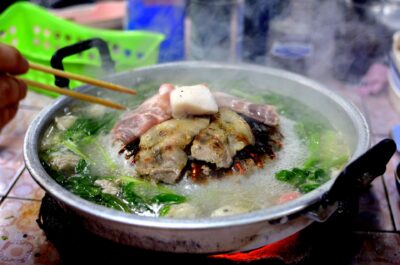 taking your time about it. This style of eating, of course, goes hand in hand with drinking, Leo beer and Thai whisky mixed with soda water are popular choices. In the center of the Mookata there is a hotplate, often a slightly raised dome, on which one places a huge variety of meats and seafood to grill to their preferred taste. It’s great fun, if not a bit of a challenge, to get your raw ingredients and cook them yourself. It encourages conversation and leaves no opportunity for people to go on their phones, if you don’t cook then you don’t eat. Another reason Mookata is so popular is because it’s essentially all you can eat, a buffet where you can order or go up and collect whatever ingredients you fancy. The most popular meats are chicken, beef, pork and shrimp, but other seafood, tofu and a variety of veg is usually available. Circling the central hotplate is a ring of broth, like Chinese hotpot, in which you can cook your ingredients. Make sure to add some noodles, I love putting in a raw egg too. You can choose your ingredients and then whether to grill or boil them, and do it all exactly to your taste, what fun. Once whatever you’ve been cooking is ready to be devoured, you can elevate it even more by dipping it in some Nam Chim sauce, a delicious sauce that goes well with everything you could possibly throw on or in the Mookata. I would like the option of making my own dipping sauce like at Chinese hotpot, but hey, you can’t have it all. Going for Mookata is great night and always delicious without damaging the wallet too much.
taking your time about it. This style of eating, of course, goes hand in hand with drinking, Leo beer and Thai whisky mixed with soda water are popular choices. In the center of the Mookata there is a hotplate, often a slightly raised dome, on which one places a huge variety of meats and seafood to grill to their preferred taste. It’s great fun, if not a bit of a challenge, to get your raw ingredients and cook them yourself. It encourages conversation and leaves no opportunity for people to go on their phones, if you don’t cook then you don’t eat. Another reason Mookata is so popular is because it’s essentially all you can eat, a buffet where you can order or go up and collect whatever ingredients you fancy. The most popular meats are chicken, beef, pork and shrimp, but other seafood, tofu and a variety of veg is usually available. Circling the central hotplate is a ring of broth, like Chinese hotpot, in which you can cook your ingredients. Make sure to add some noodles, I love putting in a raw egg too. You can choose your ingredients and then whether to grill or boil them, and do it all exactly to your taste, what fun. Once whatever you’ve been cooking is ready to be devoured, you can elevate it even more by dipping it in some Nam Chim sauce, a delicious sauce that goes well with everything you could possibly throw on or in the Mookata. I would like the option of making my own dipping sauce like at Chinese hotpot, but hey, you can’t have it all. Going for Mookata is great night and always delicious without damaging the wallet too much.
Larb
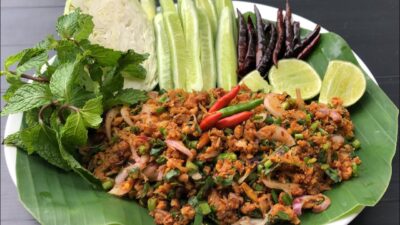 My first mouthful of Larb Pla Duk, catfish salad, genuinely left me speechless, but don’t worry, I managed to order another plate five minutes later. This dish is truly unique and I had never tasted anything like it before in my life, a phenomenon that started happening rather a lot after arriving in Thailand. Larb hails from Laos and the Isan region of Thailand, in the northeast of the country, as does Som Tam. Akin to the great variety of Som Tam, Larb also offers a wonderful plethora of variations. In a nutshell, it’s a meat salad. It can be beef, pork, chicken, duck and fish. I’ve also had it with tofu which was really good. Meat salad in of itself doesn’t exactly sound particularly appealing, but trust me on this, it’s nothing like a salad. It’s mighty. Firstly, there is the texture of the meat, whichever one you choose, it’s perfectly crunchy and soft simultaneously, I’m not quite sure how that’s possible but somehow it is. Then there is the popping, fragrant, spicy, sour, warming, fresh and simply incredible flavor, created by combining crunchy red onions, toasted rice, galangal, dried chillies and sprigs of mint and other herbs that make the dish so fresh. Not having to worry about bones also makes this dish a winner, the majority of meat and fish in Thailand comes to your table with its bones intact, so munch with caution. This is not an issue with Larb and you can enjoy the delicious flavors freely without any hassle.
My first mouthful of Larb Pla Duk, catfish salad, genuinely left me speechless, but don’t worry, I managed to order another plate five minutes later. This dish is truly unique and I had never tasted anything like it before in my life, a phenomenon that started happening rather a lot after arriving in Thailand. Larb hails from Laos and the Isan region of Thailand, in the northeast of the country, as does Som Tam. Akin to the great variety of Som Tam, Larb also offers a wonderful plethora of variations. In a nutshell, it’s a meat salad. It can be beef, pork, chicken, duck and fish. I’ve also had it with tofu which was really good. Meat salad in of itself doesn’t exactly sound particularly appealing, but trust me on this, it’s nothing like a salad. It’s mighty. Firstly, there is the texture of the meat, whichever one you choose, it’s perfectly crunchy and soft simultaneously, I’m not quite sure how that’s possible but somehow it is. Then there is the popping, fragrant, spicy, sour, warming, fresh and simply incredible flavor, created by combining crunchy red onions, toasted rice, galangal, dried chillies and sprigs of mint and other herbs that make the dish so fresh. Not having to worry about bones also makes this dish a winner, the majority of meat and fish in Thailand comes to your table with its bones intact, so munch with caution. This is not an issue with Larb and you can enjoy the delicious flavors freely without any hassle.
Gaeng Som
We’re all familiar with Thai green and red curries, we may have even been lucky enough to enjoy the nutty flavors of Massaman or the creamy sauce of Penang, but I can guess with some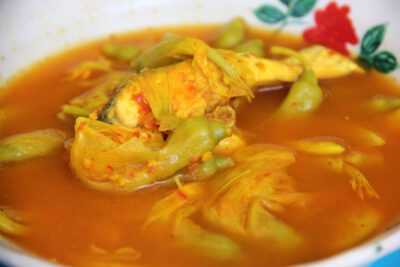 confidence that you’ve never tried Gaeng Som. That needs to change. More like a soup than a curry, this beautiful orange dish is slightly different in every restaurant you go, I love that about it. It originates from the south of the country and that’s where you’ll find the best versions of it, in my opinion. In Bangkok and further north, the dish is usually sweeter and sourer, containing shrimp and omelet with acacia leaves in. Delicious, but not laying a glove the versions I’ve had in the south, with some of the best fish I’ve ever eaten and incredible veg that soaks up the sauce so well. The paste is made from vibrant orange, fresh turmeric, a ton of garlic and you guessed it, a ton of chilies. It almost tastes medicinal, turmeric has a lot of health benefits and after eating the dish I always feel refreshed and energized. If you eat Gaeng Som at a good restaurant then the fish will be firm, one could mistake it for chicken, this means it’s fresh and wild caught. The most common vegetables to find in the dish are green papaya and banana stems, which both absorb the flavor perfectly, but you’ll find all sorts of veg in different variations, usually the restaurant pops in whatever they have fresh. The juice of an obscene number of limes is added before serving and boom, the Gaeng Som pops. Scoop a little over your rice with some of that beautiful fish and I’m confident you’ll have a new favorite Thai curry that blows all the rest out of the water, and one you’ll be eating at every opportunity.
confidence that you’ve never tried Gaeng Som. That needs to change. More like a soup than a curry, this beautiful orange dish is slightly different in every restaurant you go, I love that about it. It originates from the south of the country and that’s where you’ll find the best versions of it, in my opinion. In Bangkok and further north, the dish is usually sweeter and sourer, containing shrimp and omelet with acacia leaves in. Delicious, but not laying a glove the versions I’ve had in the south, with some of the best fish I’ve ever eaten and incredible veg that soaks up the sauce so well. The paste is made from vibrant orange, fresh turmeric, a ton of garlic and you guessed it, a ton of chilies. It almost tastes medicinal, turmeric has a lot of health benefits and after eating the dish I always feel refreshed and energized. If you eat Gaeng Som at a good restaurant then the fish will be firm, one could mistake it for chicken, this means it’s fresh and wild caught. The most common vegetables to find in the dish are green papaya and banana stems, which both absorb the flavor perfectly, but you’ll find all sorts of veg in different variations, usually the restaurant pops in whatever they have fresh. The juice of an obscene number of limes is added before serving and boom, the Gaeng Som pops. Scoop a little over your rice with some of that beautiful fish and I’m confident you’ll have a new favorite Thai curry that blows all the rest out of the water, and one you’ll be eating at every opportunity.
Nam Phrik
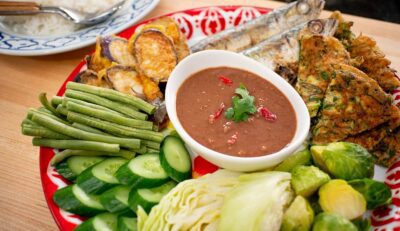 Everyone loves a dip. Whether it’s a tortilla chip in guac, pitta in hummus or popadom in chutney, we all love a dip. Well, Thailand has a truly unique dip that will change the game forever. Classily Thai, Nam Phrik is a pungent and spicy dip that may scare a few away, leaving the rest begging for more. Phrik means chili in Thai, by the way. There are hundreds of versions of this fiery dip from different regions across the country, but the standard version is made from fermented shrimp paste, a lot of chilies, onion, garlic, lime juice, palm sugar and pea aubergines. Nam Phrik isn’t shy, it slaps you in the face with its intense and addictive flavors that are complex, despite being such a simple dish. One of my favorite ways to enjoy it is on an omelet with rice, usually stuffed with canned fish or minced shrimp, it may not be the healthiest breakfast but boy it gets you ready for the day. The most popular way to enjoy Nam Phrik is actually as a dip, shock, but there are no crisps or carrot sticks in sight. Boiled vegetables are used to scoop up the lava goodness, and no, these aren’t the soggy boiled vegetables from your school dinners. These vegetables are fresh, crisp, refreshing and delicious. They cool down your mouth after the Phrik has got you. A fried mackerel is often presented beautifully alongside the veg, which, post deconstruction and using it to scoop up some dip, will reward you for your work with a perfect flavor combination. Nam Phrik can also be served with sliced up crispy omelette, deep fried aubergine, crispy pork rind and boiled eggs. Essentially, the possibilities are endless and very, very exciting.
Everyone loves a dip. Whether it’s a tortilla chip in guac, pitta in hummus or popadom in chutney, we all love a dip. Well, Thailand has a truly unique dip that will change the game forever. Classily Thai, Nam Phrik is a pungent and spicy dip that may scare a few away, leaving the rest begging for more. Phrik means chili in Thai, by the way. There are hundreds of versions of this fiery dip from different regions across the country, but the standard version is made from fermented shrimp paste, a lot of chilies, onion, garlic, lime juice, palm sugar and pea aubergines. Nam Phrik isn’t shy, it slaps you in the face with its intense and addictive flavors that are complex, despite being such a simple dish. One of my favorite ways to enjoy it is on an omelet with rice, usually stuffed with canned fish or minced shrimp, it may not be the healthiest breakfast but boy it gets you ready for the day. The most popular way to enjoy Nam Phrik is actually as a dip, shock, but there are no crisps or carrot sticks in sight. Boiled vegetables are used to scoop up the lava goodness, and no, these aren’t the soggy boiled vegetables from your school dinners. These vegetables are fresh, crisp, refreshing and delicious. They cool down your mouth after the Phrik has got you. A fried mackerel is often presented beautifully alongside the veg, which, post deconstruction and using it to scoop up some dip, will reward you for your work with a perfect flavor combination. Nam Phrik can also be served with sliced up crispy omelette, deep fried aubergine, crispy pork rind and boiled eggs. Essentially, the possibilities are endless and very, very exciting.
Pla Pao
Thailand is obsessed with fish. I’m obsessed with fish. It’s a match made in heaven. I’ve eaten all sorts of fish in all sorts of dishes, but Pla Pao has got to be up there fighting for top spot, and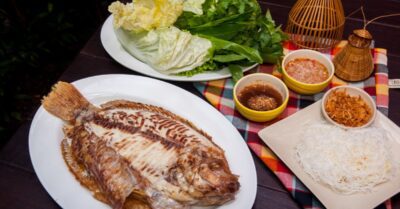 luckily for me you can find it on every street corner in every town across the kingdom. You have to get stuck into this dish, that’s what I enjoy about it, it’s made to be shared and if you don’t have completely messy hands by the end then you’re doing it wrong. Usually tilapia or red tilapia, the fish is stuffed with aromatics like lemongrass and kafir lime leaves, then it’s plastered in salt and perfectly grilled over charcoal at a low heat. The result is moist and flaky meat that is truly wonderful. But it gets better. As you may have already gathered, sauces are king in Thailand. There are two sauces most commonly eaten with Pla Pao, a spicy sauce that’s incredible, and a sweet sauce with peanuts that I’m not a big fan of. The spicy sauce, known also as Thai seafood sauce, is packed with spice and herbs, it’s delicious and if there’s any leftover, which there usually isn’t, I put it on everything for the following days. So, you have your fish, and you have the sauces, then you have a load of greens, lettuce and a variety of fragrant Thai herbs that taste like nothing you’ve had before, and there’s the soft rice noodles. Combine them all together by getting a lettuce leaf, adding some ripped herbs followed by noodles and of course fish, topped off with some sauce and you’ll make an absolute mess trying to get in into your mouth, but it will be so very worth it.
luckily for me you can find it on every street corner in every town across the kingdom. You have to get stuck into this dish, that’s what I enjoy about it, it’s made to be shared and if you don’t have completely messy hands by the end then you’re doing it wrong. Usually tilapia or red tilapia, the fish is stuffed with aromatics like lemongrass and kafir lime leaves, then it’s plastered in salt and perfectly grilled over charcoal at a low heat. The result is moist and flaky meat that is truly wonderful. But it gets better. As you may have already gathered, sauces are king in Thailand. There are two sauces most commonly eaten with Pla Pao, a spicy sauce that’s incredible, and a sweet sauce with peanuts that I’m not a big fan of. The spicy sauce, known also as Thai seafood sauce, is packed with spice and herbs, it’s delicious and if there’s any leftover, which there usually isn’t, I put it on everything for the following days. So, you have your fish, and you have the sauces, then you have a load of greens, lettuce and a variety of fragrant Thai herbs that taste like nothing you’ve had before, and there’s the soft rice noodles. Combine them all together by getting a lettuce leaf, adding some ripped herbs followed by noodles and of course fish, topped off with some sauce and you’ll make an absolute mess trying to get in into your mouth, but it will be so very worth it.
Hoy Tod
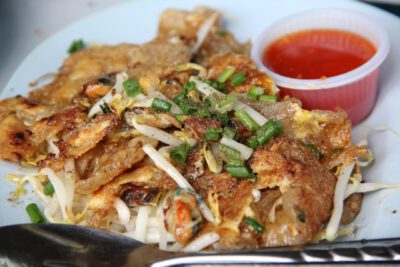
Before coming to Thailand I had absolutely no idea that omelets were such a big thing, they really are. However, they’re quite different to the omelets we’re used to back home. There are no nonstick pans, no cheese, no mushrooms, no vegetables at all really, there is no delicate folding and absolutely no toast. I always saw omelets as a healthy meal, light and full of veg and protein. I’m afraid Thai omelets didn’t get the memo. They’re deep fried, crispy, eggy goodness stuffed with a variety of fillings, they’re to be eaten with rice and spice, in the form of a tomato and chili sauce. Minced pork is very popular option but Hoy Tod, oyster omelet, is my favorite. I’m aware that this may not appeal to everyone, but there’s something quite special and unique about the combination of crispy, oily egg, beansprouts and the occasional oyster that gives the dish it’s signature taste, and don’t forget the lashings of chili. You’ll be able to find this dish on street corners across Thailand, it costs just over 50p so give it a go. If it’s not for you then I’m sure you’ll have no difficulties finding another street food stand right next door. It’s a naughty meal when you need something crispy, oily and delicious, it goes really well with beer too, which is handy.
Roti + Curry
This wonderful dish is a lot easier to find in southern Thailand where the Muslim population is larger, sadly, I live in the center of the country and don’t get to enjoy it as much as I’d like, but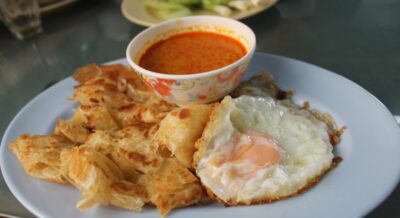 whenever I head south, I head for roti and curry straight away. Originating slightly further west, I had always associated roti and curry with countries like India and Pakistan, but in southern Thailand you’ll find a lot of crossovers, resulting in incredible food that’s a fusion of southern Asian and southeast Asian cuisine. It’s wonderful watching the sellers splat out the roti dough, kneading and stretching it before adding it to the hotplate among the chaos of twenty or so others, with confidence they know exactly what stage of cooking each one is at and not letting any become overdone. Stuffed rotis are slightly different, they’re popular around the whole country, especially in tourist areas as a quick, cheap and easy snack. They’re usually filled with banana, Nutella, cheese, condensed milk and so on, more often than not they’re sweet. Don’t get me wrong, they’re nice, but that’s not what I want to tell you about. It’s all about curry. Chicken, beef, fish or vegetable, they are incredible. Almost like a creamy, spicy, fragrant soup, it’s the perfect breakfast combined with roti, which you can use to scoop out bits of meat or mop up the delicious curry. I recommend roti with egg inside and a fried egg on top, it’s perfect to do your dirty work with, even more eggy deliciousness with every scoop and bite. If you are in southern Thailand, Phuket especially, then don’t miss the opportunity to eat roti and curry.
whenever I head south, I head for roti and curry straight away. Originating slightly further west, I had always associated roti and curry with countries like India and Pakistan, but in southern Thailand you’ll find a lot of crossovers, resulting in incredible food that’s a fusion of southern Asian and southeast Asian cuisine. It’s wonderful watching the sellers splat out the roti dough, kneading and stretching it before adding it to the hotplate among the chaos of twenty or so others, with confidence they know exactly what stage of cooking each one is at and not letting any become overdone. Stuffed rotis are slightly different, they’re popular around the whole country, especially in tourist areas as a quick, cheap and easy snack. They’re usually filled with banana, Nutella, cheese, condensed milk and so on, more often than not they’re sweet. Don’t get me wrong, they’re nice, but that’s not what I want to tell you about. It’s all about curry. Chicken, beef, fish or vegetable, they are incredible. Almost like a creamy, spicy, fragrant soup, it’s the perfect breakfast combined with roti, which you can use to scoop out bits of meat or mop up the delicious curry. I recommend roti with egg inside and a fried egg on top, it’s perfect to do your dirty work with, even more eggy deliciousness with every scoop and bite. If you are in southern Thailand, Phuket especially, then don’t miss the opportunity to eat roti and curry.
Ready to have a taste yourself? Explore our Thailand program page or submit an application

